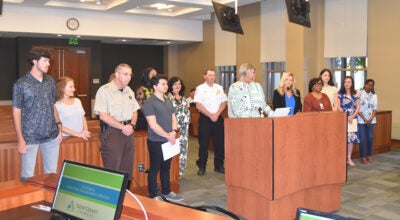Sewer system in need of repairs, costs could exceed $15M
Published 9:00 am Thursday, August 27, 2020
|
Getting your Trinity Audio player ready...
|
The City of LaGrange will likely need to invest about $15-16 million in water and sewer projects to keep those systems functional, city utility employees explained on Tuesday.
The presentation on water and sewers, given by city utilities Director Patrick Bowie, outlined the need for various repairs and projects to city council members as part of the mayor and council retreat at Great Wolf Lodge.
The city will likely reach out to the Georgia Environmental Finance Authority, a state agency which provides loans for water, sewer and solid waste infrastructure, to secure a loan to fund the projects. Such a loan would probably be low-interest and paid back over several years.
Repairs are needed for settling basins and various water system buildings in LaGrange. These structures date back to 1949, 1969 and 1992. Repairs to the settling basins and buildings are estimated to cost $5.27 million (all cost estimates include expectation of 20% contingency and 10% engineering costs).
The Mooty Bridge Lift Station, constructed in 1982, has suffered more than 20 spills since 2009 due to insufficient wet well depth and other problems, resulting in fines from Georgia’s Environmental Protection Division, Bowie said. These spills usually are the result of heavy rain. The utilities department is requesting a new pump station be built there at an estimated cost of $3.25 million.
“About once every six months, I get a nasty letter from the EPD, telling me that we’re being fined hundreds of thousands of dollars. They end up settling for $5,000,” Mayor Jim Thornton said. “We’ve got to fix this. We’ve talked about it. The cans been kicked down the road as long as we can.”
The Mooty Bridge Station pumps to the Yellow Jacket Lift Station.
Yellow Jacket Station already needs more inflow storage to handle high inflow during heavy rain, Bowie said. And, if additional capacity is added to Mooty Bridge station, Yellow Jacket would consequently receive even more water, increasing the need for more water storage.
The department is thus asking for a new storage basin at Yellow Jacket Station, estimated to cost about $2.6 million.
“It just can’t pump it all. Eventually, if something’s not done, it’s going to go into the lake,” said Ron Ellis, a sewer consultant who does work for the city, of the Yellow Jacket station.
All wastewater ends up at the Long Cane Wastewater Treatment Plant. The total water treatment capacity for the Long Cane Plant is 7.5 million gallons of water per day. The average flow in 2020 has been 6.5 MGD, except during extreme rain events which can cause spikes approaching 20 MGD, Bowie said.
“So, you’re kind of dealing with the same issues at the wastewater treatment plant that you’re dealing throughout the entire sewer system — the infiltration and inflow from the rainwater,” Bowie said.
Despite rain events causing excessive water inflow, employees have found creative solutions of storing the water elsewhere and slowly processing the water throughout the day, allowing the facility to sometimes process 18-19 MGD.
The Long Cane plant needs a new supervisory control and data acquisition (SCADA) system, a third carrousel plant clarifier to add 1-2 MGD of capacity, as well as a new belt filter press and accessories. The SCADA computer system is from 1984 and is outdated, and finding replacement parts for the system is becoming more difficult, Bowie said.
He added that the belt press is from 1992 and is worn out. The estimated cost for these improvements is about $5 million.
“That’s a lot of money, but those are the three critical things that if we don’t address, the plants not going to run,” Bowie said. “If the plant doesn’t run, we’ve got problems.”
Council member Nathan Gaskin asked if climate change was causing the heavier rainfall that necessitates better capacity. Bowie wasn’t sure if average rainfall was higher but said heavy rain events are the main cause of overflow.
City Water Superintendent Jason Clifton said other cities such as Dothan and Valdosta have delayed needed repairs and upgrades to their sewer systems and are now paying much more than if they had addressed them sooner.
“Infrastructure, pretty much all over in America was put in, you know, in the ’40s, ’50, ’60s, ’70s … those things were designed [to have] a 30, 40-year design life. We’re at 50, 60 years,” Clifton said. “This is not just LaGrange, this is every community … now they’re [Dothan and Valdosta] getting hit with $80, $100-million consent orders to address it.”





